1996 PONTIAC GRAND-AM brake
[x] Cancel search: brakePage 81 of 356
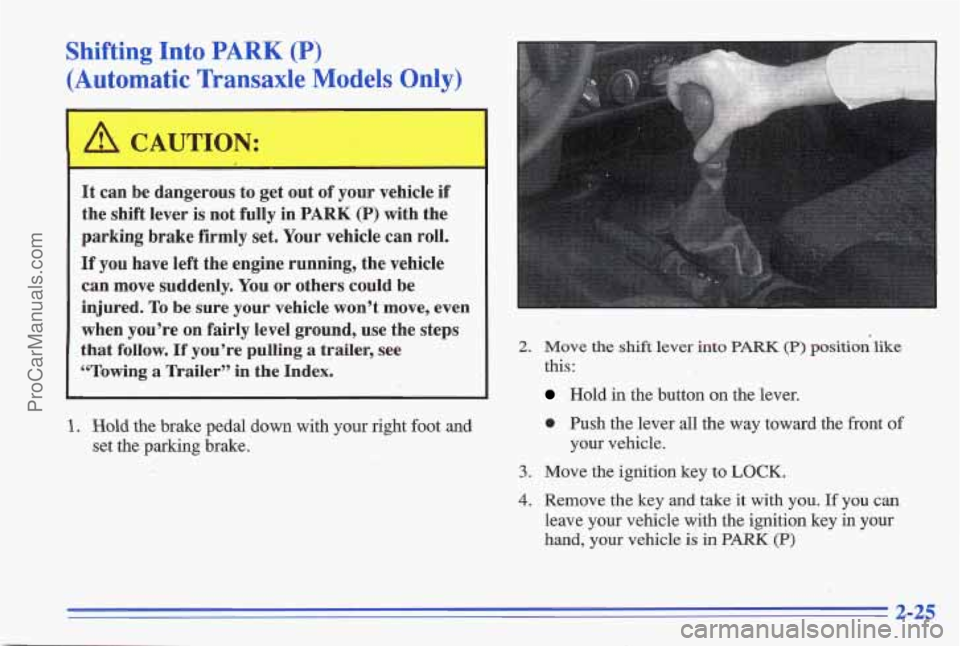
Shifting Into PARK (P)
(Automatic Transaxle Models Only)
It can be dangerous to get out of your vehicle if
the shift lever
is not fully in PARK (P) with the
parking brake firmly
set. Your vehicle can roll.
If you have left the engine running, the vehicle
can move suddenly.
You or others could be
injured.
To be sure your vehicle won’t move, even
when you’re on fairly level ground, use the steps
that
follow. If you’re pulling a trailer, see
YI‘owing
a Trailer” in the Index.
2. Hold the brake pedal down with your right foot and
set the parking brake.
2. Move the shift lever into PARK (P) position‘like
this:
Hold in the button on the lever.
0 Push the lever all the way toward the front of
your vehicle.
3. Move the ignition key to LOCK.
4. Remove the key and take it with you. If you can
leave your vehicle yith the ignition key in your
hand, your vehicle is in PARK (P)
2-25
ProCarManuals.com
Page 82 of 356

Leaving Your Vehicle With the Engine
Running (Automatic Transaxle
Models Only) -
It can be dangerous to leave your vehicle with the.
engine running, Your vehicle
could move
suddenly if the shift lever
is not fully in PARK (P)
with the parking brake firmly set. And, if you
leave the vehicle with the engine running, it could
overheat and even catch fire.
You or others could
b’e injured. Don’t leave your vehicle with the
engine running unless
you have to,
If you have to leave your vehicle with the engine
running,
be sure your vehicle is in PARK (P) and your
parking brake is firmly set before you leave it. After
you’ve moved the
shift lever into the PARK (P)
I
position, hold the regular brake pedal down. Then, see if
you can move the shift lever away from PARK (P)
without first pushing the button.
If you can, it means that the shift lever wasn’t fully
locked into PARK
(P).
Torque Lock (Automatic Transaxle)
If you are parking’on a hill and you don’t shift your
transaxle into
PARK (P) properly, the weight of the
vehicle may put too much force
on the parking pawl in
the transaxle. YOU may find it difficult to pull the shift
lever out of PARK (P), This is called “torque lock.” To
prevent torque l’ock, set &e parking brake and then shift
into
BARK (P) properly before you leave the driver’s
seat.
To find out how, see “Shifting Into PARK (P)” in
the Index.
When you
are ready to drive, move the shift lever out Qf
PARK (P) before you release the parking brake.
If torque lock does opcus, you may need to have another
vehicle push yours
a little uphill to take some of the
pressure from the transaxle,
so you can pull the shift
lever out of PARK (P).
2-26
ProCarManuals.com
Page 83 of 356
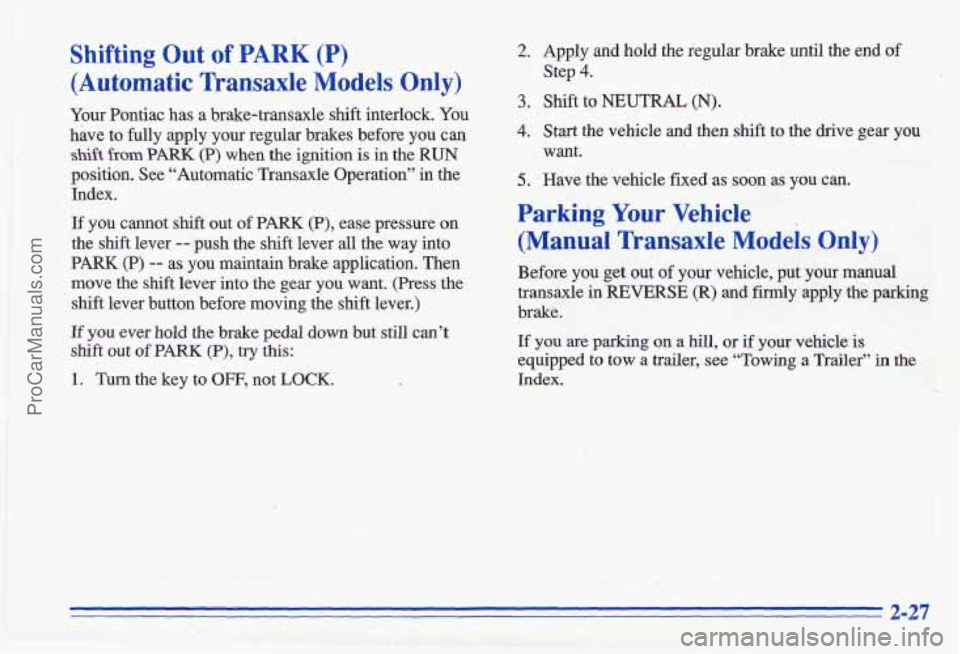
Shifting Out of PARK (P)
(Automatic Transaxle Models Only)
Your Pontiac has a brake-transaxle shift interlock. You
have to fully apply your regular brakes before you can
shift from PARK (P) when the ignition is in the RUN
position. See “Automatic-Transaxle Operation” in the
Index.
If you cannot shift out of
PARK (P), ease pressure wn
the shift lever -- push the shift lever all the way into
PARK (P)
-- as you maintain brake application. Then
move the shift lever into the gear you want. (Press the
shift lever button before moving the shift lever.)
If you ever hold the brake pedal down but still can’t
shift
out of PARK (P), try this:
1. Turn the key to OFF, not LOCK. , ,<. j:~+!-,. , , ‘(, . .I. ”
,..I_ . , , . P ., , :. a -9 -- ....,. 4 -’. .:‘.I..: .,:- ;.
i.. ’ .--4 ..
2.
3.
4.
5.
Apply and hold the regular brake until the end of
Step
4.
Shift to NEUTRAL (N).
Start the vehicle and then shift to the drive gear you
want.
Have the vehicle fixed
as soon as you can.
Parking Your Vehicle
(Manual Transaxle Models Only)
Before you get out of your vehicle, put your manual
transaxle in’REVERSE
(R) and firmly apply the-parking
brake.
If you are parking on a hill, or if your vehic1e.k
equipped to tow
a trailer, see “Towing a Trailer” in the
Index.
ProCarManuals.com
Page 85 of 356
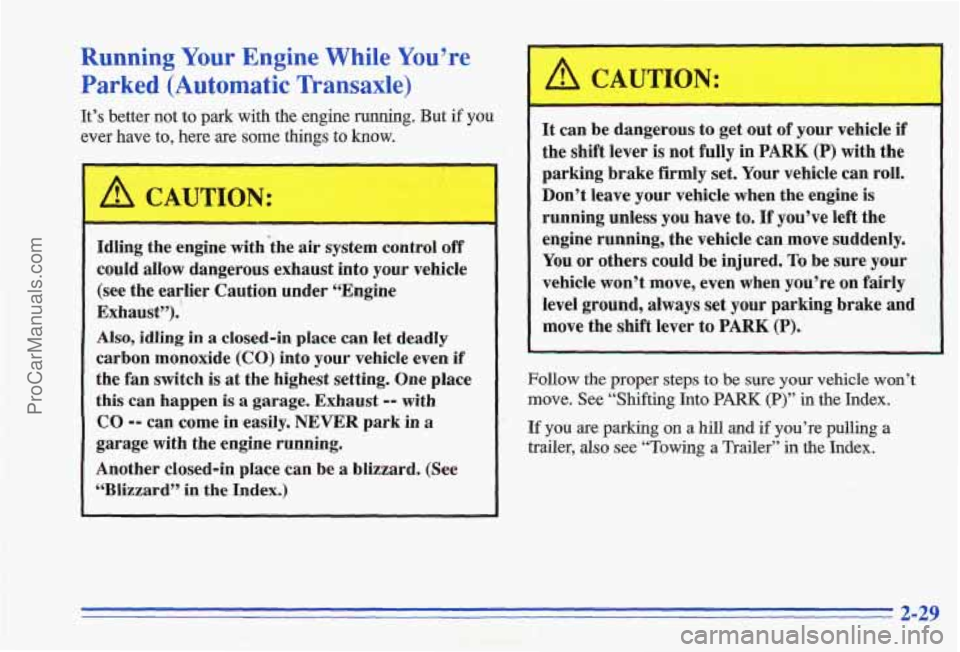
Running Your Engine While You’re
Parked (Automatic Transaxle)
It’s better not to park with the engine running. But if you
ever have to, here are some things to know.
/$ CAUTION:
Idling the engine with the air system control off
could allow dangerous exhaust into your vehicle
(see the earlier Caution under “Engine
Exhaust”).
Also, idling in a closed-in place can let deadly
carbon monoxide
(CO) into your vehicle even if
the fan switch is at the highest setting. One place
this can happen
is a garage. Exhaust -- with
CO -- can come in easily. NEVER park in a
garage with the engine running.
Another closed-in place can be
a blizzard. (See
“Blizzard” in
the Index.)
1
It can be dangerous to get out of your vehicle if
the shift lever
is not fully in PARK (P) with the
parking brake firmly set. Your vehicle can roll.
Don’t leave your vehicle when the engine is
running unless you have to.
If you’ve left the
engine running, the vehicle can move suddenly.
You or others could be injured.
To be sure your
vehicle won’t move, even when you’re on fairly
level ground,
always set your parking brake and
move the shift lever to PARK (P).
Follow the proper steps to be sure your vehicle won’t
move. See “Shifting Into PARK (P)” in the Index.
If you are parking on a hill and if you’re pulling a
trailer? also see “Towing a Trailer” in the Index.
2-29
ProCarManuals.com
Page 91 of 356
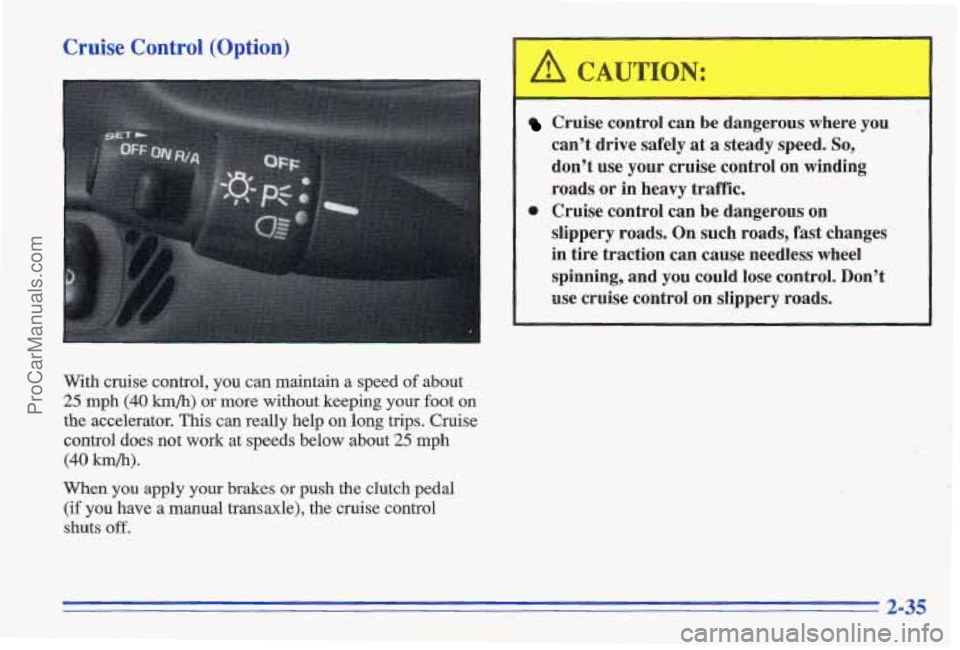
Cruise Control (Option)
With cruise control, you can maintain a speed of about
25 mph (40 h/h) or more without keeping your foot on
the accelerator. This can really help on long trips. Cruise
control does not work at speeds below about
25 mph
(40 hh).
When you apply your brakes or push the clutch pedal
(if you have a manual transaxle), the cruise control
shuts
off.
Cruise control can be dangerous where you
can't drive safely at a steady speed. So,
don't use your cruise control on winding
roads or in heavy traffic.
slippery roads. On such roads, fast changes
in tire traction can cause needless wheel
spinning, and
you could lose control. Don't
use cruise control on slippery roads.
0 Cruise control can be dangerous on
2-35
ProCarManuals.com
Page 93 of 356

Resuming a Set Speed
I
Suppose you set your cruise control at a desired speed
and then you apply the brake. This,
of course, shuts off
the cruise control. But you don’t need to reset it. Once
you’re going about
25 mph (40 km/h) or more, you
can move the cruise control switch from
ON to
R/A (Resume/Accelerate) for about half
a second.
You’ll go right back up to your chosen speed and stay
there.
If you hold the switch at R/A longer than half a second,
the vehicle will keep going faster until you release the
switch or apply the brake, or clutch pedal
(if you have a
manual transaxle). You could be startled and even lose
control.
So unless you want to go faster, don’t hold the
switch to R/A.
’
Increasing Speed While Using Cruise Control
There are two ways to go to a higher speed. Here’s the
first:
1. Use the accelerator pedal to get to the higher speed.
2. Push the SET button at the end of the lever, then
release the button and the accelerator pedal.
You’ll now cruise
at the higher speed.
Here’s the second way to go to a higher speed:
Move the cruise switch from ON to R/A. Hold it
there until you get up to the speed you want, and
then release the
switch.
To increase your speed in very small amounts, move
the switch to R/A for less than half a second and then
release it. Each time you
do this, your vehicle will go
about 1 mph (1.6 h/h) faster.
2-37
ProCarManuals.com
Page 94 of 356
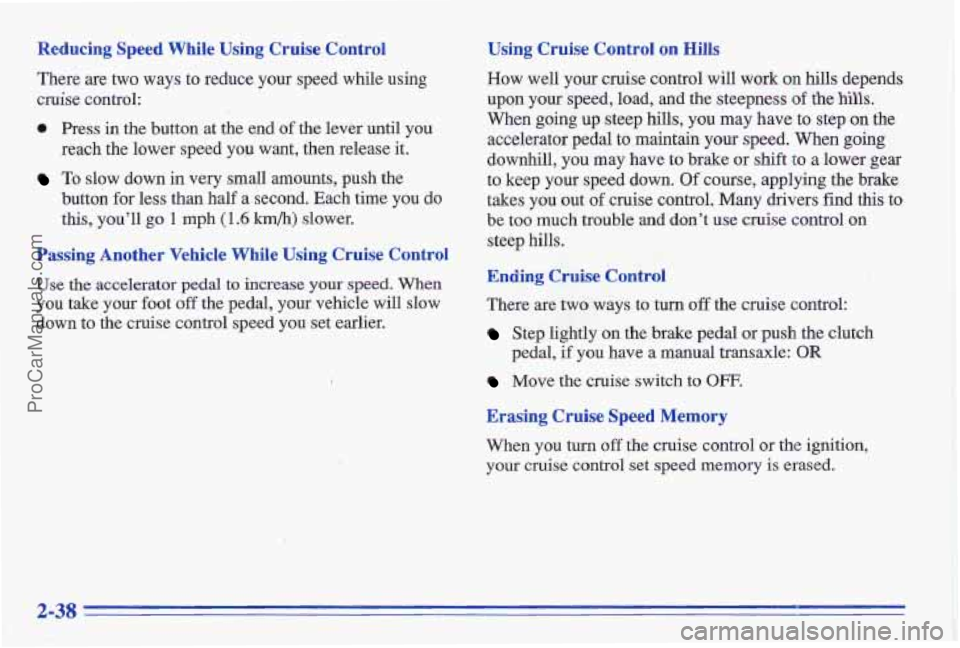
Reducing Speed While Using Cruise Control
There are two ways to reduce your speed while using
cruise control:
0 Press in the button at the end of the lever until you
reach the lower speed you
want, then release it.
To slow down in very small amounts, push the
button
for less than half a second. Each time you do
this, you'I1 go 1 mph (1.6 h/h) slower.
Passing Another Vehicle While Using Cruise Control
Use the accelerator pedal to increase your speed. When
you take your foot
off the pedal, your vehicle will slow
down to the cruise control speed you set earlier.
I'
Using Cruise Control on Hills
How well your cruise control will work on hills depends
upon your speed, load, and the steepness of the bills.
When going up steep hills, you may have to step on the
accelerator pedal to-maintain your speed.
When going
downhill, you may have to brake
or shift to a lower gear
to keep your speed down. Of course, applying the brake
takes
YOU out of cruise control. Many driven find this to;
be too much trouble and don't use cruise control on
steep
hills.
'Ending Cruise Control
There are two ways to turn off the cruise control:
Step lightly on the brake pedal or push the clutch
pedal,
if you have a manual transaxle: OR
Move the cruise switch to OFF.
Erasing Cruise Speed Memory
When you turn off the cruise control or the ignition,
your cruise control set speed memory is erased.
ProCarManuals.com
Page 96 of 356

Lamps On Reminder
If you open the driver's door while leaving the lamps on
and the ignition off, you will hear a warning chime.
Daytime Running Lamps
Daytime Running Lamps (DRL) caw make it easier for
others to see the front of
your vehicle during the day.
DRL caw be helpful in many different driving
conditions, but they
can be especially helpful in the
short periods after dawn
and before sunset.
The
DRL system will make your high-beam headlamps
come
on at reduced brightness when:
The ignition is on,
, The headlamp switch is OFF,
The light sensor sees daytime light, and
0 The parking brake is released (manual transaxle), or
0 The shift lever is not in PARK (P) or NEUTRAL (N)
When the DRL are on, only your high-beam headlamps
will
be on. The taillmps, sidemarker and other lamps
won't be on. Your instrument panel wonY be lit up
either. (automatic transaxle). When
it's dark enough outside,
your headlamps will
come on at full brightness.
The other lamps that come
on with your headlamps will also come on. A light
sensor ,on top of the instrument panel turns the
headlamps oh and the DRL ,system off. Be sure the light
sensor isn't covered. When it's bright enough outside,
the regular
lamps will go off and your high-bem
headlamps will change
to the reduced brightness of the
DRL.
To idle your vehicle with the DRL off, set the parking
brake on
a manual transaxle or put the vehicle in
PARK (P) or NEUTRAL (N) on an automatic transaxle,
while the ignition is in the OFF or LOCK position. Then
start the vehicle, The DRL will stay off until you release
the
parking brake on a manual transaxle or shift out of
PARK (P) or NEUTaAL (N) on an automatic transaxle.
As with any vehicle,
you should turn on the regular
headlamp system when you need
it.
ProCarManuals.com